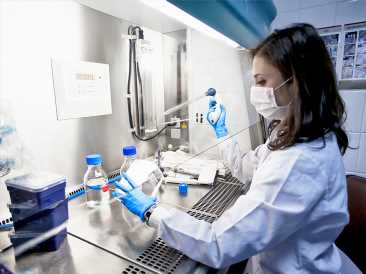Combination cancer vaccine effective in mouse models

Scientists have developed a new vaccine for treating cancer. It combines chemotherapy and immunotherapy, and it has shown promise in mouse models.
A team of scientists has recently developed a new vaccine for treating cancer, and it has shown promising results in mice — even in difficult-to-treat cancer.
The treatment combines chemotherapy and immunotherapy in a single injection, which may open the door to a personalized, highly effective, and easy-to-administer therapy.
The research, which appears in the journal Nature Communications, will now need to move to preclinical trials, which may then lead to trials in humans.
Cancer treatment
Two key approaches to treating cancer are chemotherapy and immunotherapy.
According to the National Cancer Institute (NCI), chemotherapy aims to kill cancer cells by stopping or reducing their growth.
However, it can also affect healthy cells, so it typically causes significant side effects for the person receiving it. These effects may include tiredness, nausea, hair loss, and mouth sores.
On the other hand, the NCI explain that immunotherapy mobilizes a person’s immune system to target cancer cells.
Often, the immune system will do this without any support. However, cancers can protect themselves from a person’s immune system. Immunotherapy helps increase the immune system’s effectiveness.
Immunotherapy also comes with side effects, which will vary depending on the type of immunotherapy a person is receiving. Furthermore, for the most difficult-to-treat cancers — such as triple-negative breast cancer — immunotherapy generally has limited effects.
According to co-first study author Dr. Hua Wang, an assistant professor in the Department of Materials Science and Engineering at the University of Illinois at Urbana-Champaign, “Triple-negative breast cancer does not stimulate strong responses from the immune system, and existing immunotherapies have failed to treat it.”
“In our system, the immunotherapy attracts numerous immune cells to the tumor while the chemotherapy produces a large number of dead cancer cell fragments that the immune cells can pick up and use to generate an effective tumor-specific response.”
By combining the two cancer treatments, the scientists behind the new research are hoping to get the “best of both worlds.”
Long-term research
The treatment the team tested in the new study is the result of over 10 years of development.
In 2009, a group led by corresponding study author Prof. David Mooney — Robert P. Pinkas Family Professor of Bioengineering at the Harvard John A. Paulson School of Engineering and Applied Sciences in Cambridge, MA — reported that they had developed an implantable cancer vaccine that showed promise in mouse models.
The vaccine worked by combining tumor-associated antigens (TAAs), which provoke the body’s immune response, with adjuvants, which improve the effectiveness of the immune response. This results in a personalized cancer treatment that should be more effective.
However, doing so involves either harvesting antigens from a person’s tumor or identifying antigens through genome sequencing — both of which are expensive and require a considerable amount of time.
According to co-first study author Alex Najibi, a graduate student in Prof. Mooney’s laboratory, “[o]ne of the critical limiting factors in the development of cancer vaccines is the selection of TAAs, because currently we only have a very small library of known antigens for a few specific tumor cell lines, and it’s difficult to predict which can mount an effective immune response.”
“Implanting chemotherapy drugs inside the vaccine scaffold creates a burst of cancer cell death that releases TAAs directly from the tumor to the dendritic cells, bypassing the long and costly antigen development process.”
Combination vaccine
The scientists applied this technique to mice with triple-negative breast cancer and found that it enabled the chemotherapy drugs to penetrate tumors more effectively. This resulted in an increase in the death of cancer cells and the development of fewer tumors.
Having had success combining chemotherapy and immunotherapy treatments in a single vaccine, the team then experimented by adding a third component. This was a synthetic bacterial DNA sequence, which previous studies have shown to improve the body’s immune response.
The researchers found that this additional component further reduced the growth of tumors and increased the life span of the mice.
When analyzing which effects the three-component vaccine was having in the mice, the team noticed an increase in the protein PD-L1 on the surface of the mice’s tumors. This protein is used by tumors to avoid detection by the body’s immune system.
By injecting the mice both with the three-component vaccine and with an anti-PD-1 checkpoint inhibitor, which blocks a tumor’s evasion of the immune system, the scientists saw even better results.
The size and number of tumors in the mice were significantly reduced.
Furthermore, the mice survived for an average of 40 days, compared with 27 days for mice not receiving any treatment and 28 days for mice only receiving the anti-PD-1 treatment.
Finally, after removing the triple-negative breast cancer tumors from the mice and treating them with the gel-based vaccine, the scientists saw that the mice had much lower tumor recurrence, slower tumor growth, and better survival rates.
Significantly, after the researchers reintroduced cancer cells to the mice they treated with the vaccine, none of them developed new tumors. In contrast, all the mice who did not receive the vaccine but did receive new cancer cells died of the disease.
The team now plans to continue optimizing the vaccine, and, in particular, to target other types of cancer that are also difficult to treat. Further ahead, the scientists hope that their vaccine will move into preclinical and then human trials.
Source: Read Full Article
